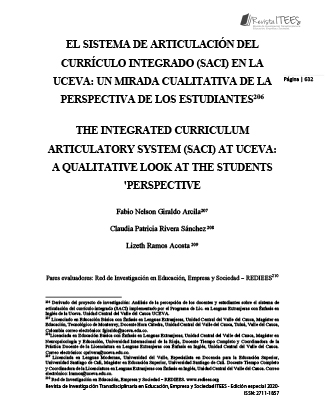XXXII. THE INTEGRATED CURRICULUM ARTICULATORY SYSTEM (SACI) AT UCEVA: A QUALITATIVE LOOK AT THE STUDENTS 'PERSPECTIVE
##plugins.themes.bootstrap3.article.main##
Abstract
The Faculty of Educational Sciences in affinity with the Interstructurant Integrative
Pedagogical Model of Uceva under which the pedagogical practices are developed has
implemented an articulation system that leads students to raise a proposal around an
integrating question through the synergy of all the subjects. The present research sought to
know the perception of students about the Integrated Curriculum Articulation System
(SACI), implemented by the Uceva Bachelor's Program in Foreign Languages with Emphasis
in English, becoming input for restructuring, and strengthening process of it giving to know
the possible adjustments that the instruments require and their implementation. For this
purpose, a qualitative method was used that involved the collection and analysis of
information, which allowed a better understanding of the students' perception of the
Articulatory System. Based on this, it was found the students consider that the system
responds to the principles of the Interstructuring Integrative Pedagogical Model implemented
in the Uceva in such a way that it contributes significantly to their professional teacher
training from both a practical and social sphere. From this perspective, it was possible to
establish that the system successfully articulates the competencies established from each area
of knowledge from a formative evaluation approach from a contemporary feedback model.
Download Statistics
##plugins.themes.bootstrap3.article.details##
integrative, interstructuring, articulation, feedback, formative evaluation
Enseñanza e Investigación en Psicología, 18 (2), 293-305.
Cassany, D. (2003) Aproximaciones a la lectura crítica: teoría, ejemplos y reflexiones.
Tarbiya, revista de Investigaciones e Innovación Educativa. Núm. 32, 113-132.
Gallardo, K. et al. (2012) Toma de decisiones para la evaluación formativa: el proceso de
planeación y determinación de sus mecanismos. Revista Electrónica Sinéctica, Núm.
39, 1-19.
Garello, M. V. y Rinaudo, M. C. (2013). Autorregulación del aprendizaje, feedback y
transferencia de conocimiento. Investigación de diseño con estudiantes universitarios.
Revista Electrónica de Investigación Educativa, 15(2), 131-147.
Giraldo, A. (2020) Modelo de retroalimentación. En Giraldo C. y Ramirez, E, Sistema de
Articulación del Currículo Integrado (SACI). (págs. 32–40).
Hattie, J y Timperley, H. (2007). The power of feedback. Review of Educational Research,
77(1), 81-112. DOI: 10.3102/003465430298487.
Maldonado, R. (2009) Sobre la retroalimentación o el feedback en la educación superior on
line. Revista Virtual Universidad Católica del Norte. Núm. 26, 1-18
Ramos Acosta, L. (2019). Reflexiones sobre la formación de docentes de lengua extranjera
en Colombia. Revista Boletín Redipe, 8(7), 61-72
Rivera, C. (2019). Cómo se adquiere el aprendizaje desde el estudio neuropsicológico de los
procesos mentales de la memoria y las funciones ejecutivas. En A. Varios,
Apropiación, gestión y uso edificador del conocimiento 2019 (págs. 293-309). Cali y
Palmira: Redipe.
Rivera, C. et al. (2017). Assessment strategy by competences to develop critical reading in
fifth grade students, International Journal of Current Research, 9, (08), 55993-55999.





